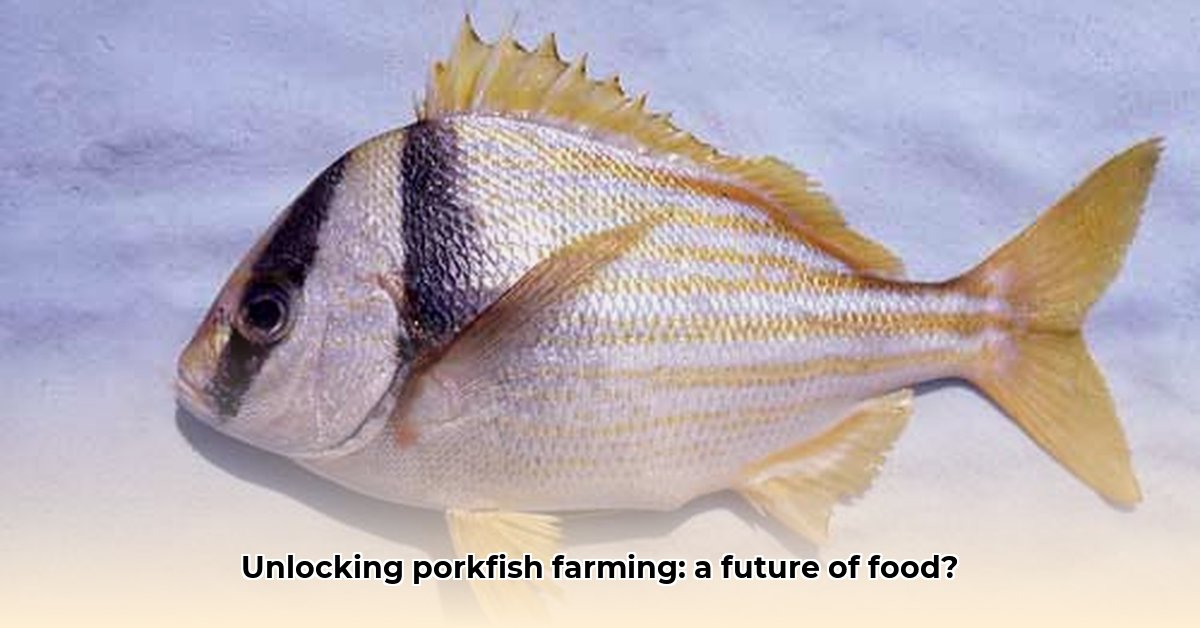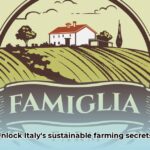Imagine a future where delicious, sustainably-farmed porkfish grace our dinner tables. It sounds promising, right? But farming these colorful fish isn’t as simple as it seems. This article explores the exciting potential of Atlantic porkfish aquaculture, but also the very real challenges. We’ll look at how scientists are successfully breeding these fish in captivity, the hurdles they’re facing and the biggest worry: a dangerous toxin called ciguatera that can sometimes be found in porkfish. We’ll also explore ways to avoid this toxin, the rules and regulations involved in porkfish farming, and how everyone from farmers to consumers can play a part in making this industry a success while protecting the environment. Learn more about sustainable farming practices from North American farmers.
Porkfish Aquaculture: Opportunities and Overcoming Obstacles
Porkfish have a potentially big future in aquaculture. But there are some hurdles to jump before it becomes a common sight on our dinner plates. This article explores the exciting possibilities of porkfish farming, but also the very real challenges that need to be addressed. Aquaculture businesses face certain challenges to establish viable Atlantic Porkfish farming.
The Appeal of Sustainable Porkfish Farming
Porkfish, scientifically known as Anisotremus virginicus, are looking like a promising candidate for aquaculture. Several successful breeding programs have already shown that raising them in captivity is possible. What’s more, these fish seem pretty easy to handle. However, before we get too excited, there are some important questions to answer about whether porkfish farming is truly a sustainable solution for the broader consumption of seafood.
Farming Porkfish: A Balancing Act
One big advantage of porkfish is their diet. They’re omnivores, meaning they eat both plants and animals. This makes it easier to create a balanced diet for them in a farm setting. The challenge here is to develop a food that helps them grow quickly and keeps them safe from accumulating ciguatera toxin.
Interestingly, porkfish also have a natural role as “cleaner fish” in their environment, meaning they help keep other fish healthy by eating parasites. This could inspire some clever ways to manage parasites in a farm setting without relying so heavily on chemical treatments.
But let’s take a look at the good and the bad:
| Feature | Pros | Cons |
|---|---|---|
| Diet | Omnivorous – easier to formulate food | Need research for optimal growth and toxin prevention |
| Temperament | Relatively calm and tolerant of human interaction | Long-term effects of captivity on behavior are unknown |
| Reproduction | Captive breeding has been achieved | Spawning induction (getting them to reproduce in captivity) needs more work |
| Disease Management | The cleaner fish role hints at natural parasite control options | Susceptibility to common fish farm diseases is still unclear |
| Ciguatera Toxin Danger | Potential for monitoring and control strategies | A serious danger for human health if the toxin levels get too high |
Tackling the Tough Stuff: Research and Solutions
To make porkfish farming work, we need progress in several key areas:
- Getting them to Spawn: We need to better understand how to get porkfish to reproduce successfully in a controlled environment. This involves exploring different techniques, such as manipulating hormones or carefully controlling environmental conditions.
- The Perfect Food: Creating a diet that promotes fast growth while minimizing the risk of ciguatera toxin is crucial. This will involve careful attention to what they are fed, at what stages of their lives. Thorough monitoring is needed at every stage of growth.
- Keeping Them Healthy: We need to learn more about the specific diseases that are likely to affect porkfish in a farming setting and implement biosecurity measures to prevent sickness. Strategies like using other cleaner fish for parasite control are showing promise.
- The Ciguatera Toxin Challenge: Regular, rigorous testing to keep tabs on toxin levels is a must. Finding ways to remove or reduce the toxin, whether before or after harvest, needs further research.
Rules, Regulations, and Collaboration for Porkfish Farming
The success of the porkfish aquaculture industry hinges on carefully designed rules and regulations. We will need clear guidelines regarding safe toxin levels in the fish, along with systems to monitor production closely and honest labeling of the final product. This needs the cooperation of many groups—the companies raising the fish, research institutions, government bodies, and ultimately, consumers. Everyone plays a critical role.
The Porkfish Aquaculture Outlook: A Cautious Optimism
Porkfish aquaculture has fantastic potential, but it’s vital to proceed cautiously. We need to continue investing in research, collaborate effectively, and prioritize sustainable practices. The future of this industry depends on carefully managing both the advantages and the risks to ensure its long-term viability. The journey ahead will require ongoing effort, scientific advancements, and commitment to responsible aquaculture practices.
How to Mitigate Ciguatera Toxin Risk in Atlantic Porkfish Aquaculture
Key Takeaways:
- Atlantic porkfish offer aquaculture potential due to their adaptability and omnivorous diet.
- Ciguatera toxin contamination is a major hurdle to overcome for sustainable porkfish farming.
- Successful mitigation strategies involve careful feed management, rigorous monitoring, and robust regulatory frameworks.
- Collaboration between stakeholders is critical for achieving safe and sustainable porkfish aquaculture.
Aquaculture Potential of Atlantic Porkfish: Exploring the Opportunities
Atlantic porkfish possess several traits making them promising aquaculture candidates. They’re relatively docile, tolerate human interaction well, and readily consume a variety of readily available feeds. Successful captive breeding and larval rearing programs demonstrate their adaptability to controlled environments. This opens exciting possibilities for a sustainable seafood source. But there’s a significant obstacle: ciguatera toxin (CTX).
The Ciguatera Toxin Challenge for Atlantic Porkfish
Ciguatera toxin (CTX) is a potent neurotoxin accumulating in the food chain. Predatory fish, like porkfish, are particularly vulnerable to bioaccumulation. Consuming CTX-contaminated porkfish poses a serious health risk to humans. Therefore, how to mitigate ciguatera toxin risk in Atlantic porkfish aquaculture is paramount.
Mitigation Strategies: A Multi-pronged Approach
Successfully farming porkfish while minimizing CTX risk requires a multifaceted approach.
- Controlled Diets: Carefully managing the porkfish diet is essential. This involves providing feed free from CTX-producing organisms (like certain dinoflagellates). Research into optimal feed formulations that minimize bioaccumulation is ongoing.
- Rigorous Monitoring: Implementing stringent monitoring protocols is crucial. Regular testing of both feed and porkfish samples for CTX presence is needed. This ensures early detection of any contamination, facilitating prompt corrective action.
- Selective Breeding: Selective breeding programs may help reduce CTX accumulation. Research focusing on identifying and breeding porkfish strains exhibiting lower CTX bioaccumulation potential could be highly impactful.
- Water Quality Management: Maintaining optimal water quality in aquaculture farms is crucial. This minimizes the presence of dinoflagellates and other potential toxin producers in the fish’s environment.
- Size Restrictions: Controlling the size of harvested porkfish helps. Larger fish typically contain higher toxin concentrations. Establishing and enforcing size limits can significantly minimize consumer exposure.
Regulatory Landscape and Stakeholder Collaboration for Safe Farming
Effective regulation is vital. Clear guidelines on acceptable CTX levels in porkfish, coupled with robust monitoring and enforcement mechanisms, will protect human health and foster consumer confidence. Strong collaboration is key. This includes involving aquaculture businesses, research institutions, regulatory agencies, and of course, consumers. Each stakeholder plays a vital role in ensuring the sustainable development of the porkfish aquaculture industry.
Looking Ahead: Sustainable Porkfish Farming
Successfully integrating Atlantic porkfish into aquaculture depends on successfully addressing the CTX challenge. By combining careful feed management, rigorous monitoring, stringent regulations, and collaborative efforts, we can move toward a sustainable and safe porkfish aquaculture industry. This requires ongoing research and innovative solutions, but the potential benefits – a sustainable and delicious food source – are worth striving for.
Atlantic Porkfish Aquaculture: Sustainable Practices and Environmental Impact
Key Takeaways:
- The Atlantic porkfish presents exciting possibilities for aquaculture, offering a potentially sustainable seafood source.
- Successful captive breeding and larval rearing demonstrate feasibility, but significant challenges remain.
- Careful management is crucial to mitigate risks, particularly concerning ciguatera toxin and environmental impact.
- Collaboration among stakeholders—producers, researchers, regulators, and consumers—is vital for responsible development.
- Further research and sustainable practices are crucial.
















